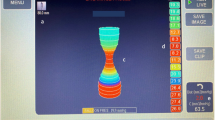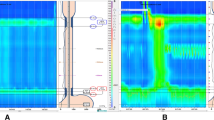Résumé
Objectif: Répondre à un certain nombre d’interrogations, classées en:
-
-
2 objectifs principaux:
-
•
Quel est l’apport de la manométrie dans le diagnostic précoce de l’achalasie ?
-
•
A-t-elle un impact sur l’orientation du geste thérapeutique ?
-
-
2 objectifs accessoires:
-
•
Quelle est la fréquence de l’achalasie chez les patients explorés en manométrie œsophagienne ?
-
•
Existe t’il des caractéristiques spécifiques chez ces patients ?
Matériel et méthode: Etude rétrospective de 388 cas de suspicion d’achalasie, sur 1434 examens manométriques réalisés au service, sur une période de 10 ans allant de janvier 1990 à décembre 2000. Seuls 184 cas ont été retenus selon nos critères d’inclusion.
Le matériel et la technique de manométrie œsophagienne utilisés ont été conformes aux règles méthodologiques préconisées par l’Agence Nationale d’Accréditation et d’Evaluation en Santé (ANAES).
L’analyse statistique a été faite à l’aide d’un logiciel SPSS.
Résultats: La prévalence de l’achalasie dans notre série était de 12,8 %. La dysphagie était le maître symptôme retrouvé dans 97,3 % des cas. Le délai moyen entre l’apparition des signes cliniques et le diagnostic manométrique était de 38,2 ±4 mois.
Le diagnostic de l’achalasie a été porté à un stade précoce d’achalasie vigoureuse ou hyperkinétique chez 40,2 % des patients, et à un stade d’achalasie hypokinétique dans 59,8 % des cas.
La manométrie a mis en évidence les signes majeurs de l’achalasie: une relaxation du SIO en réponse à la déglutition absente ou incomplète dans 96,7 % des cas, un apéristaltisme œsophagien dans 95,6 % des cas, et l’hypertonie du SIO, signe mineur, a été objectivée chez 80,4 % des patients.
La pression sphinctérienne était encore normale chez 60 % des patients dans le groupe d’achalasie vigoureuse ou hyperkinétique (p = 0,02).
Nous n’avons pas mis en évidence de particularités manométriques liées à l’âge, au sexe; de même, nous n’avons pas noté de différence significative entre la fréquence des signes cliniques, et les données manométriques: la pression du SIO, la relaxation et l’apéristaltisme.
Conclusion: La manométrie œsophagienne est incontournable pour le diagnostic précoce d’achalasie, alors que les autres examens sont encore normaux. La précocité du diagnostic permet d’améliorer les résultats fonctionnels post-thérapeutiques. La réalisation de la manométrie pré-opératoire oriente l’acte thérapeutique.
Summary
Aims of study:To answer to a certain number of questions:
-
-
Two essential aims:
-
•
What is the contribution of manometry in the early diagnosis of achalasia?
-
•
Its impact on therapeutic procedure orientation?
-
-
And two accessory objectives:
-
•
What is the frequency of the achalasia at patients explored with esophageal manometry?
-
•
Do these patients have specific characters?
Material and method: Retrospective study of 388 cases with achalasia suspicion, on 1,434 manometry examination performed in the Functional digestive explorations department, at University hospital “Ibn Sina” of Rabat in Morocco, on a period of 10 years between January 1990 to December 2000. Only 184 cases have been kept in the clinical study, according to our inclusion criteria.
Material and technique of esophageal manometry used were compliant to the methodological rules recommended by the French National Agency of Health Accreditation and Evaluation (ANAES). The statistical analysis has been made with the help of a software SPSS.
Results:Prevalence of the achalasia in our study was 12,8 %. Dysphagia was the main symptom found in 97,3 % of cases. The mean delay between apparition of clinical signs and manométrie diagnosis was 38,2 ± 4 months.
The diagnosis of achalasia was made at an early stage of vigorous or hyper kinetic achalasia in 40,2 % of patients, and at a stage of hypokinetic achalasia in 59,8 % of cases.
Manometry diagnoses the major signs of the achalasia: relaxation of the LES in response to an absent or incomplete swallowing in 96,7 % of cases, esophageal aperistalsis in 95,6 % of cases, and hypertonic LES as a minor sign, was found in 80,4 % of patients.
Sphincterian pressure was even normal in 60 % of patients in the group of vigorous or hyperkinetic achalasia (P = 0,02).
We did not note any manometric particularities bound to age or gender, neither did we note any significant difference between the frequency of clinical signs, and manometric data: the pressure of the LES, relaxation and the absence of peristalsis.
Conclusion:Esophageal manometry is indispensable for early diagnosis of achalasia, even if the other exams are normal. The forwardness of the diagnosis allows to improve the posttherapeutic functional results. The realization of the preoperative manometry orients the therapeutic act.
Similar content being viewed by others
Références
VAEZI M.F., RICHTER J.E. — Diagnosis and Management of achalasia.Am. College Gastroenterol., 1999,94 (12), 3406–3412.
METMAN E.H., ADDRA B., D’ALTEROCHE L. — Troubles moteurs primitifs de l’œsophage.La revue du Praticien, 1998,48, 2235–2239.
XIe Congrès Mondial de Gastroentérologie. Vienne: 6–11 Septembre 1998.
PETER J., KAHRILAS M.D. — An American Gastroenterological Association Medical Position Statement on the Clinical USE of Oesophageal Manometry.Gastroenterology, 1994,107, 1865–1884.
BOULANT J., JIAN R. — Recommandations pour la pratique de la manométrie œsophagienne chez l’adulte.Gastro. Enterol. Clin. Biol., 1998,22, 1081–1094.
AMRANI N., KANOUNI N., DAKKA T., NYA M. — Les troubles moteurs de l’œsophage au cours de la sclérodermie systémique. A propos de 97 cas.Acta Endoscopica, 2001,31 (2), 211–222.
HOWARD P.J., MAHER L., PRYDE A., CAMERON E.W., HEADING R.C. — Five year prospective study of the incidence, clinical features, and diagnosis of achalasia in Edinburgh.Gut, 1992,33, 1011–1015.
OUNG C., D’ALTEROCHE L., FOURQUET F. — Evolution of clinical and radiological features at diagnosis of achalasia during a 19-year period in central France.Eur. J. Gastroenterol. Hepatol., 2001,13 (2), 121–126.
MAYBERRY J.F. — Epidemiology and Demographics of achalasia.Gatrointestinal Endosc. Clinics N. America, 2001,11 (2), 235–247.
HOWARD P.J., MAHER L., PRYDE A., CAMERON E.W., HEADING R.C. — Five year prospective study of the incidence, clinical features, and diagnosis of achalasia in Edinburgh.Gut, 1992,33, 1011–1015.
HO K.Y. — A prospective study of the clinical features, manometric finding, incidence and prevalence of achalasia in Singapore.J Gastroenterol. Hépatol., 1999,14 (8), 791–795.
DIALLO G., ONGOIBA N., MAIGA M. — Mégaœsophage Idiopathique au Mali.Méd. Chir. Dig., 1998,27, 111–112.
JOHN G., HUNTER M.D. — Surgical management of achalasia.Surgical Clinics of North America, 1997,77(5), 993–1015.
MARCO G., PATTI M.D. — Minimally Invasive Surgery for Achalasia.Annals of Surgery, 1999,230 (4).
SCOTTE M., TENIERE P. — Résultats à long terme du traitement chirurgical de l’achalasie de l’œsophage.J. Chir., 1991,128(6–7), 281–284.
AL BAROUDI M.A. — Mégaœsophage Idiopathique: à propos de 95 cas.Thèse de médecine n∘ 143, Rabat, 1995.
BERRADA S., RIDAI M., ZEROUALI N.O. — L’opération de Heller dans le traitement du mégaœsophage idiopathique.Ann. Chir., 1992,46(4), 352–354.
MOUMEN M., MOKHTARI M., CHERKAOUI A., ELFARES F. — L’intervention de Heller dans le traitement du mégaœsophage idiopathique.J. Chir., 1993,130(3), 130–133.
OUIJJA M. — Le mégaœsophage idiopathique: à propos de 38 cas.Thèse de médecine n∘ 35, Rabat, 1995.
FAULQUES B., GIRMAUD J.C., MOGES B., PERYOT J. — Traitement de l’achalasie par dilatation pneumatique.La Presse Médicale, 1989,18(9), 468–470.
ELLIS F.H. — Oesophagomyotomy for achalasia: a 22-year expérience.Br. J. Surg., 1993,80, 882–885.
NAHON S., BOUDET M.J.et al. — Achalasie mimant les troubles du comportement alimentaire.Gastroenterol. Clin. Biol., 2001,25, 313–315.
STACHER G., KISS A., WIEESNAGROTZKI S. — Symptoms of achalasia in young woman mistaken as indicating primary anorexia nervosa.Dysphagia, 1990,5, 216–219.
KISS A., BERGMANN H., ABATZI T.A., SCHNEIDER C., WIESNAGROTSKI S., HÖBART J., STEINER-MITTEL-BACH G., GAUPMANN G., KUGI A., STACHER-JANOTTA G., STEINRINGER H., STACHER G.— Oesophageal and gastric motor activity in patients with boulimia nervosa.Gut, 1990,31, 259–265.
SABATE J.M., GAUDRIC M., DOUSSET B., COUTU-RIER D. — Dysphagie chez un trisomique adulte opéré pour atrésie de l’œsophage: achalasie ou pseudo-achalasie.Gastroenterol. Clin. Biol., 1999,23, 573–576.
RAYMOND L. — Inflammatory aetiology of primary oesophageal achalasia: an immunohistochemical and ultrastructural study of Auerbach’s plexus.Histopathology, 1999,35 (5), 445–453.
COUTURIER D. — Troubles moteurs primitifs de l’œsophage (achalasie, spasme diffus, syndrome du péristaltisme douloureux, formes intermédiaires).Progrès en Hépato-Gastroentérologie, 1987, 37–52.
HIRANO I.et al. — Manométric Heterogeneity in Patients With Idiopathic Achalasia.Gastroenterology, 2001,120, 789–798.
MEARIN F. — Complete lower oesophageal sphincter relaxation observed in some achalasia patients is functionally inadequate.Am. J. Physiol Gastrointest. liver Physiol., 2000,41 (3).
FEKETE F., BREIL P.H. — Les réinterventions après intervention de Heller pour achalasie et autres dysfonctionnements moteurs de l’œsophage.Acta Chirurgica Bélgica, 1982,4, 333–343.
ALONSO P. — Achalasia: the usefulness of manometry for evaluation of treatment.Dig. Dis. Sci., 1999,44 (3), 536–541.
JOHN G., HUNTER M.D., THADEUS L.— Laparoscopic Heller Myotomy and Fundoplication for Achalasia.Ann. Surg., 1997,225 (6), 655–664.
DEL GENIO A., IZZO G., DI MARTINO N. — Intraoperative oesophageal manometry: our experience.Diseases of the oesophagus, 1997,10, 253–261.
ROSATI R., FACS M.D., FAMAGALLI U. — Laparoscopic approach to Oesophageal achalasia.Am. J. Surg., 1995,169, 424–427.
ZANINOTTO G. — Treatment of Esophageal achalasia with laparoscopic Heller myotomy and Dor partial anterior fundoplication: prospective evaluation of 100 consecutive patients.J. Gastrointest. Surg., 2000,4 (3), 282–289.
PARILLA M.D., MARTINEZ DE HARO M.D. — Factors involved in the return of peristalsis in Patients with Achalasia of the Cardia after Heller’s Myotomy.Am. J. Gastroenterol., 1995,90 (5), 713–719.
SHIINO Y. — Manométrie and radiographie verification of oesophageal body decompensation for patients with achalasia.J. Am. College of Surgeons, 1999,189 (2), 158–163.
VAEZI M.F. — Quantitative methods to determine efficacy of treatment in achalasia.Gastrointestinal Endosc. Clinics N. America, 2001,11 (2), 409–424.
Author information
Authors and Affiliations
About this article
Cite this article
Amrani, N., Serraj, I., Kanouni, N. et al. La manométrie œsophagienne est-elle incontournable dans la prise en charge de l’achalasie ?. Acta Endosc 33, 781–794 (2003). https://doi.org/10.1007/BF03002624
Issue Date:
DOI: https://doi.org/10.1007/BF03002624




